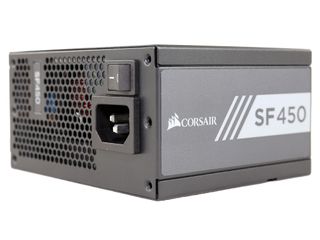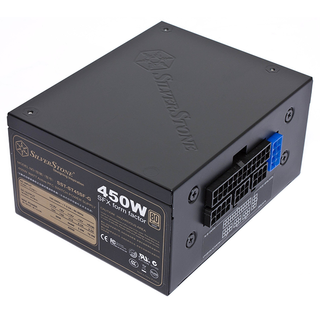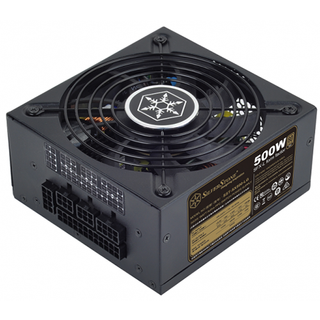Corsair SF450 PSU Review
Corsair enters the SFX PSU market with its new SF series consisting of two models at 450W and 600W capacities. Both power supplies are fully modular, promise high performance and come with 92mm fans to minimize noise output.
Why you can trust Tom's Hardware
Load Regulation, Hold-Up Time And Inrush Current
To learn more about our PSU tests and methodology, please check out How We Test Power Supply Units.
Primary Rails And 5VSB Load Regulation
Load Regulation testing is detailed here.








Hold-Up Time
Our hold-up time tests are described in detail here.







The hold-up time is pretty long, while the power-good signal drops before the rails go out of spec (as it should). Everything is fine here, and obviously the 390uF bulk cap is more than enough for this PSU's needs.
Inrush Current
For details on our inrush current testing, please click here.


The inrush current is low with 115V and close to normal levels with 230V input.
Load Regulation And Efficiency Measurements
The first set of tests reveals the stability of the voltage rails and the PSU's efficiency. The applied load equals (approximately) 10 to 110 percent of the maximum load the supply can handle, in increments of 10 percentage points.
We conducted two additional tests. During the first, we stressed the two minor rails (5V and 3.3V) with a high load, while the load at +12V was only 0.10A. This test reveals whether a PSU is Haswell-ready or not. In the second test, we determined the maximum load the +12V rail could handle with minimal load on the minor rails.
| Test # | 12V | 5V | 3.3V | 5VSB | DC/AC (Watts) | Efficiency | Fan Speed (RPM) | Noise (dB[A]) | Temps (In/Out) | PF/AC Volts |
|---|---|---|---|---|---|---|---|---|---|---|
| 1 | 1.923A | 1.994A | 1.972A | 0.991A | 44.78 | 80.41% | 1000 | 19.9 | 37.97 °C | 0.965 |
| 12.061V | 5.019V | 3.343V | 5.030V | 55.69 | 46.36 °C | 115.1V | ||||
| 2 | 4.887A | 2.990A | 2.964A | 1.191A | 89.76 | 86.90% | 1000 | 19.9 | 39.22 °C | 0.983 |
| 12.053V | 5.013V | 3.336V | 5.024V | 103.29 | 48.07 °C | 115.0V | ||||
| 3 | 8.202A | 3.497A | 3.479A | 1.395A | 134.89 | 89.24% | 1120 | 20.9 | 39.49 °C | 0.982 |
| 12.045V | 5.007V | 3.331V | 5.017V | 151.16 | 48.64 °C | 115.0V | ||||
| 4 | 11.512A | 3.995A | 3.967A | 1.596A | 179.76 | 90.18% | 1470 | 26.6 | 41.13 °C | 0.981 |
| 12.039V | 5.002V | 3.324V | 5.010V | 199.34 | 50.54 °C | 115.0V | ||||
| 5 | 14.483A | 4.998A | 4.972A | 1.795A | 224.72 | 90.59% | 1725 | 28.3 | 41.94 °C | 0.984 |
| 12.034V | 4.993V | 3.318V | 5.003V | 248.07 | 51.50 °C | 115.0V | ||||
| 6 | 17.452A | 6.014A | 5.978A | 2.000A | 269.73 | 90.42% | 2100 | 35.0 | 42.64 °C | 0.987 |
| 12.031V | 4.987V | 3.310V | 4.995V | 298.32 | 52.40 °C | 115.0V | ||||
| 7 | 20.427A | 7.023A | 6.991A | 2.200A | 314.69 | 90.33% | 2400 | 40.0 | 42.82 °C | 0.989 |
| 12.026V | 4.979V | 3.303V | 4.989V | 348.37 | 52.91 °C | 115.0V | ||||
| 8 | 23.408A | 8.044A | 8.006A | 2.405A | 359.73 | 90.02% | 2775 | 41.3 | 43.92 °C | 0.991 |
| 12.020V | 4.972V | 3.296V | 4.983V | 399.61 | 54.34 °C | 115.0V | ||||
| 9 | 26.811A | 8.555A | 8.534A | 2.410A | 404.77 | 89.71% | 3180 | 45.5 | 44.17 °C | 0.992 |
| 12.017V | 4.967V | 3.292V | 4.978V | 451.19 | 55.25 °C | 115.0V | ||||
| 10 | 30.168A | 9.072A | 9.035A | 2.510A | 449.61 | 89.34% | 3450 | 45.1 | 44.30 °C | 0.993 |
| 12.013V | 4.962V | 3.287V | 4.974V | 503.24 | 56.27 °C | 115.0V | ||||
| 11 | 33.926A | 9.073A | 9.043A | 2.512A | 494.55 | 89.05% | 3675 | 45.2 | 44.84 °C | 0.994 |
| 12.008V | 4.958V | 3.284V | 4.970V | 555.39 | 57.74 °C | 115.0V | ||||
| CL1 | 0.102A | 12.009A | 12.005A | 0.004A | 100.82 | 84.15% | 2370 | 37.8 | 43.70 °C | 0.985 |
| 12.056V | 4.983V | 3.309V | 5.031V | 119.81 | 51.55 °C | 115.1V | ||||
| CL2 | 37.481A | 1.003A | 1.003A | 1.001A | 463.56 | 90.23% | 3345 | 45.0 | 44.07 °C | 0.993 |
| 12.012V | 4.986V | 3.314V | 5.008V | 513.74 | 55.61 °C | 115.0V |
Load regulation is very tight on the +12V rail. It's good on the others as well, with 5V and 5VSB achieving 1.21% and 1.41% respectively, and the 3.3V rail a little higher with 1.76% deviation. In addition, the SF450 easily meets the 80 PLUS Gold requirements at 50% output and full load. It's only 0.1% off in the 20% load test, though we benchmark in a much hotter ambient environment than the 80 PLUS organization. It's common knowledge that a PSU's efficiency is significantly affected by high operating temperatures, and this accounts for the difference.
Up to the 50% load test, the fan's noise stays below 30 dB(A). Again, we had to push the small PSU hard to make its fan spin fast enough to exceed 40 dB(A). Under normal conditions, the fan profile is relaxed so you won't have to worry about excess noise. On the next page, you will find a graph that illustrates the fan's noise under normal conditions.
Current page: Load Regulation, Hold-Up Time And Inrush Current
Prev Page A Look Inside And Component Analysis Next Page Efficiency, Temperature And NoiseStay On the Cutting Edge: Get the Tom's Hardware Newsletter
Get Tom's Hardware's best news and in-depth reviews, straight to your inbox.

Aris Mpitziopoulos is a contributing editor at Tom's Hardware, covering PSUs.
-
spdragoo Interesting...a small-factor PSU with enough power & PCIe connectors for those with a prebuilt system that want to upgrade their GPUs without having to rebuild the entire system from scratch.Reply -
turkey3_scratch Reply17801331 said:"No berg connector," is a con? And this is why Johnnyguru is the better website.
I find it hard to believe you actually read power supply reviews, because on Jonnyguru OklahomaWolf always scores against having a berg connector. Also, Jonnyguru only tests a few things compared to Aris's reviews on Tomshardware and Techpowerup.
Edit: I just realize I misinterpreted what you said. I do apologize, it was my mistake. I did not realize the word "not". Yes, Aris and Jonnyguru have different reviews on berg connectors. I still don't think that just because a berg connector is a good thing means that Jonnyguru is a better review site. That seems to be an extremely minor detail to judge one whole review site to this one. -
Onus Hmmm, looks like the only thing not to like is that all the SATA connectors are on one cable, which could be a problem even in some small cases where this would be used; the optical drive might not be near the other drives.Reply -
jimmysmitty Reply17801372 said:Hmmm, looks like the only thing not to like is that all the SATA connectors are on one cable, which could be a problem even in some small cases where this would be used; the optical drive might not be near the other drives.
And that is easy to solve since you will probably be able to buy cables and change the molex out for another SATA cable, like all Corsair PSUs.
I wish this was out when I rebuilt my HTPC. Would have preferred it since what was available at the time was just meh and nowhere near the performance. -
turkey3_scratch Just finished review. Great unit, wonderful. I'd take this over one of the Silverstones any day.Reply -
Aris_Mp Reply"No berg connector," is a con? And this is why Johnnyguru is the better website.
Some components still need a berg connector ( e.g. sound card panels, fan controllers, etc.) And it costs almost nothing to add a berg adapter into the bundle.
-
JQB45 Exciting to see more SFF power supplies of good quality. Now I have even less reason not to buy a mini-itx case next time.Reply -
turkey3_scratch Reply17801331 said:"No berg connector," is a con? And this is why Johnnyguru is the better website.
On second read of your post, I misinterpreted what you said, and I do apologize. I thought you were upset that including a berg connector was a con, I'm sorry I misinterpreted it. Yeah, this unit doesn't have a berg connector. Here's the thing: you have OklahomaWolf who scores against having berg connectors, and you have Aris who likes to see berg connectors. Two complete opposite subjective standpoints. What I don't understand is how this makes Jonnyguru a better site.
Whenever I read power supply reviews, I always ignore the conclusion page. I usually don't read it. The information is all there for you to judge. Whether or not the author thinks a berg connector is good or bad is an opinion, but it does not detract from how professional Aris's reviews are. I mean, come on, Jonnyguru does not test transient response, hold-up time, AC_LOSS to PWR_OK, 1500 crossload possibilities, extensive efficiency and fan RPM, etc. tests. I just can't see how Jonnyguru can be a better review site because they only do a fractional amount of testing.
Jonnyguru's resources are limited, so it's understandable. I think some people like Jonnyguru just because of how "fast" one can fly through the reviews. It takes me a solid 25 minutes of thorough analysis to read Aris's reviews, I can go through a Jonnyguru one in under 10 minutes. There is just so much information here, so why is it you think Jonnyguru is a better site? -
AlistairAB Thank you Tom's Hardware for highlighting the lack of the SFX adapter bracket. It can be purchased directly from Corsair at the following link:Reply
http://www.corsair.com/en-us/sfx-to-atx-psu-adapter-bracket
This was also mentioned in a newegg.ca review, and received many down votes. Perhaps this is because of American focused reviews, so most people think it is not a big deal to order a $5.99 adapter directly from Corsair or through a 3rd party.
However this is actually a serious mistake, as ordering this to Canada from Corsair requires over $50 USD in shipping. Total cost for the bracket after shipping and taxes is over $80 CAD which is absolutely ridiculous for a part with no retail availability or alternatives that should have been included in the box.
I talked with Corsair support this morning and opened a ticket, and they provided exemplary customer service and have now promised to send the adapter to me in Canada for free. Perhaps this will work for some of you having the same problem.
There are many small form factor cases that accept ATX PSUs that need this bracket (Silverstone and Lian Li cases), where the short cable lengths don't pose a problem.


